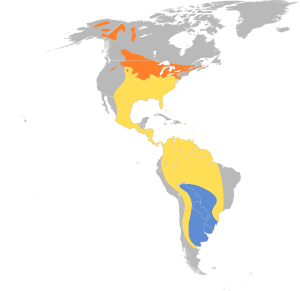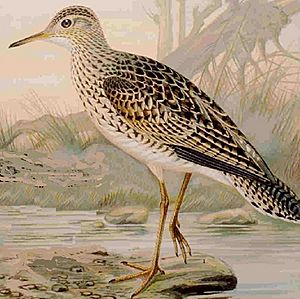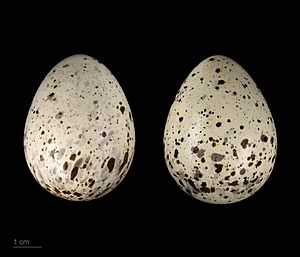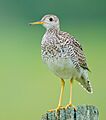Upland sandpiper facts for kids
Quick facts for kids Upland sandpiper |
|
|---|---|
 |
|
| Conservation status | |
| Scientific classification | |
| Genus: |
Bartramia
|
| Species: |
longicauda
|
 |
|
| Synonyms | |
|
|
The upland sandpiper (Bartramia longicauda) is a unique type of sandpiper. It is a large bird that is closely related to curlews. This bird has also been called the upland plover or Bartram's sandpiper. In Louisiana, some people call it the papabotte. It is the only species in its group, called the Bartramia genus.
The name Bartramia and the old name "Bartram's sandpiper" honor an American nature expert named William Bartram. The scientific name longicauda comes from Latin words. Longus means "long" and caudus means "tail," which describes this bird's long tail. Another bird expert, Alexander Wilson, helped make the name "Bartram's sandpiper" popular. He learned about birds and drawing from William Bartram.
Contents
What Does the Upland Sandpiper Look Like?
An adult upland sandpiper is about 30 centimeters (12 inches) long. Its wings can spread out to about 66 centimeters (26 inches) wide. On average, these birds weigh around 170 grams (6 ounces). This interesting bird has a small head, like a dove, on a long neck.
Its back and wings are a mix of black and brown patterns. Dark brown streaks run down its neck to its chest and sides. Its belly and the feathers under its tail are white. The tail is quite long for a sandpiper. The upland sandpiper also has a white ring around its eyes and long, yellow legs.
Where Do Upland Sandpipers Live?
Upland sandpipers breed in many parts of North America. They can be found from eastern Alaska through Montana to northern Oklahoma. Their breeding range also extends northeast to Pennsylvania, New England, and southern Quebec and Ontario. There are also smaller groups that breed in northeast Oregon and west-central Idaho.
When winter comes, these birds fly south. They spend the colder months in northeastern Argentina, Uruguay, and southern Brazil. It is very rare to see them in the South Pacific. There has only been one sighting in Australia and one in New Zealand.
What Kind of Places Do They Prefer?
Even though they are called sandpipers, these birds do not usually live near the coast. They prefer open areas with tall grasses. You might also find them at airports, blueberry farms, or old strip mines in the eastern United States. Their main home and favorite habitat are in the northern Midwest of the United States.
How Do Upland Sandpipers Behave and What Do They Eat?
Upland sandpipers look for food in fields. They spot their food by sight. You can often see them sitting on fence posts or even telephone poles. When an "uppy" lands, it holds its wings up for a few seconds. They are always looking around for anything that might be a danger.
The upland sandpiper eats many different things. Their diet includes grasshoppers, crickets, weevils, beetles, moths, ants, flies, bugs, centipedes, millipedes, spiders, snails, and earthworms. They also eat some grains and seeds.
Reproduction and Life Cycle
Upland sandpipers sometimes nest in small groups. Their breeding season is from early to late summer. They build their nests on the ground, hidden in thick grass. The female bird lays four eggs.
Both parents take care of their young. They might pretend to be hurt to trick predators and lead them away from the nest or their baby birds. This helps keep their young safe.
What Does the Upland Sandpiper Sound Like?
You can recognize upland sandpipers by their special call. It sounds like a "wolf whistle." This call starts with a long whistle that goes higher in pitch. Then, there is a second call that might go up or down. They often make these sounds when they are landing or flying high in the sky.
Why Are Upland Sandpipers Important to Protect?
The number of upland sandpipers grew when forests were cut down in the early 1800s. However, their numbers dropped a lot in the late 1800s because of hunting. Now, they are regularly found in the Midwestern part of North America. But in the eastern areas, their groups are spread out.
Losing their prairie homes is a big worry for these birds. Also, when farm animals graze in fields, it can reduce the number of nests. Controlled burns, which are fires set on purpose to manage land, can help these birds. They eat low-growing plants that are easier to see after a fire.
See also
 In Spanish: Correlimos batitú para niños
In Spanish: Correlimos batitú para niños
Images for kids






